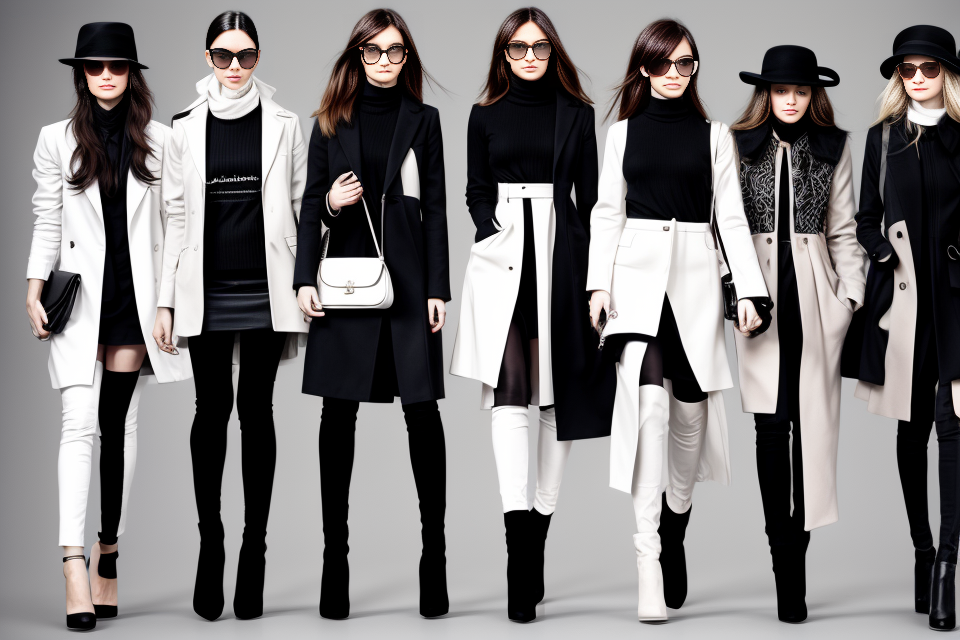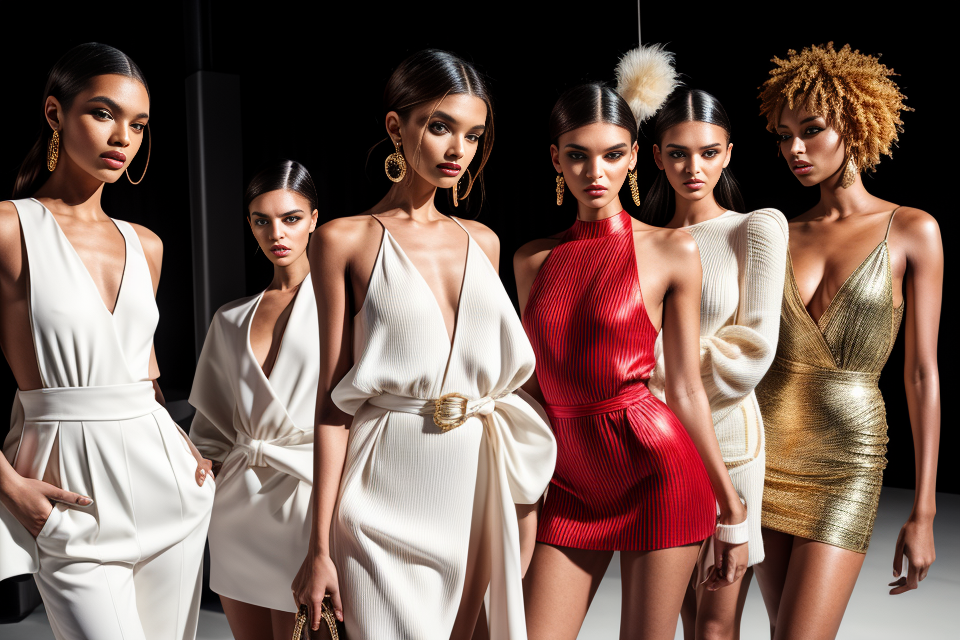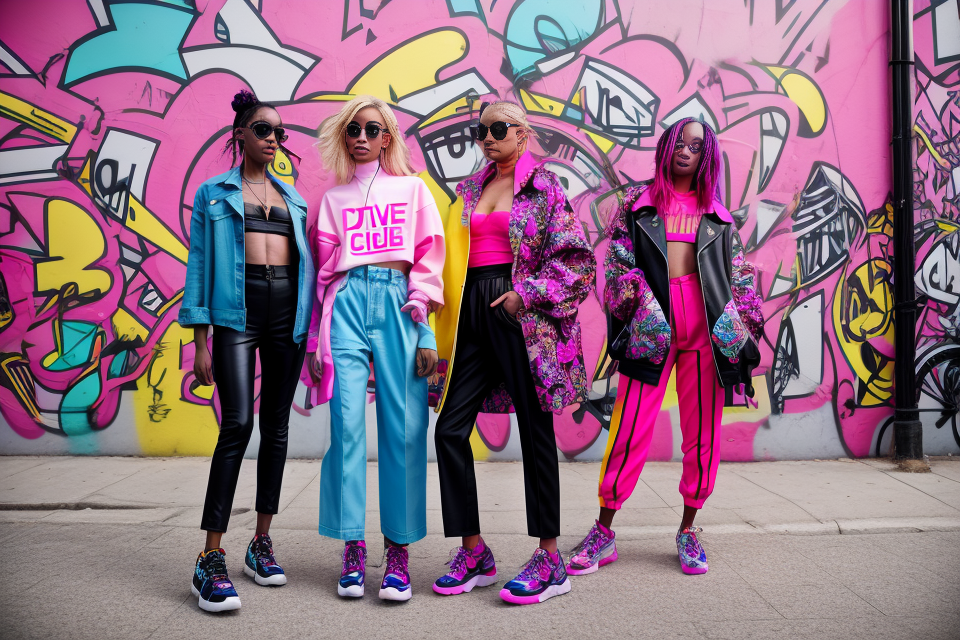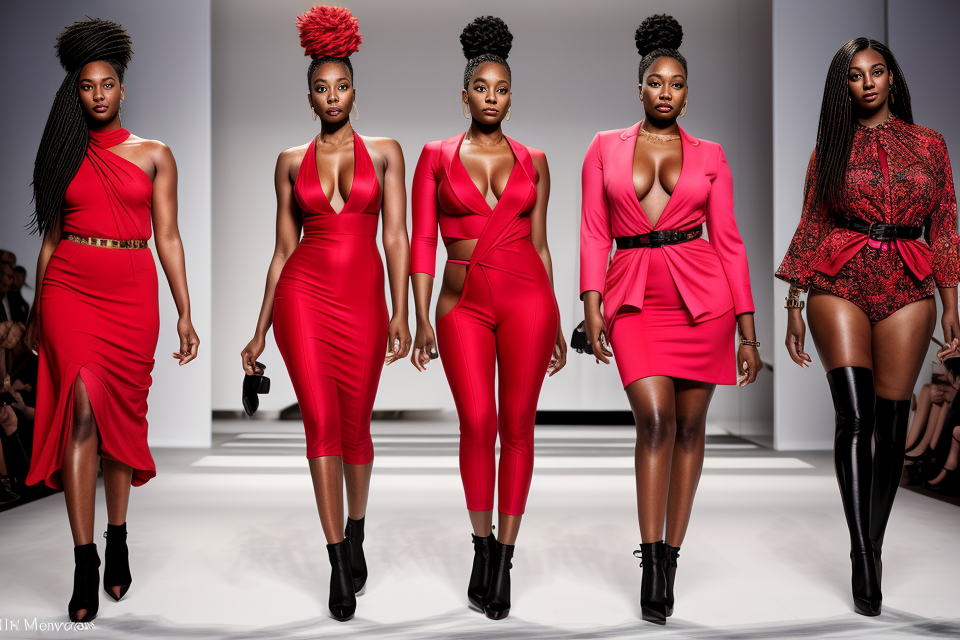
Fashion trends are constantly changing and evolving, and it can be challenging to keep up with the latest styles. But have you ever wondered about the different stages that a fashion trend goes through before it becomes a mainstream phenomenon? In this article, we will explore the five stages of fashion trends and how they influence the way we dress and express ourselves. From the emergence of a new style to its peak and eventual decline, we will delve into the exciting world of fashion trends and discover what makes them tick. So, let’s get started and explore the fascinating journey of fashion trends!
The 5 stages of fashion trends are: 1) Introduction: When a new style or trend first emerges and gaining popularity. 2) Growth: As more people adopt the trend, it becomes more mainstream and widely accepted. 3) Maturity: The trend reaches its peak popularity and becomes a staple in fashion. 4) Decline: As trends become less relevant, they start to fade away and lose popularity. 5) Obsolescence: The trend is no longer considered fashionable and is eventually replaced by a new trend.
Understanding Fashion Trends
The Cycle of Fashion Trends
The cycle of fashion trends is a recurring pattern that describes the lifespan of a fashion trend. This pattern consists of five stages: the rise, peak, decline, resurgence, and reincarnation of a trend.
The Rise of a Trend
The rise of a trend is the initial stage in the cycle of fashion trends. At this stage, a new style or trend begins to emerge, and it gradually gains popularity among fashion enthusiasts. This stage is characterized by experimentation and exploration, as people start to embrace new styles and ideas. The rise of a trend is often driven by influential celebrities, designers, and social media personalities who showcase the latest fashion trends.
The Peak of a Trend
The peak of a trend is the stage at which a fashion trend reaches its height of popularity. At this stage, the trend is embraced by the mainstream, and it becomes a staple in the fashion industry. The peak of a trend is often marked by widespread adoption, as people from all walks of life embrace the trend. During this stage, the trend is often imitated by fast fashion brands, and it becomes more accessible to the general public.
The Decline of a Trend
The decline of a trend is the stage at which a fashion trend begins to lose its popularity. At this stage, people start to move on to new trends, and the trend becomes less relevant. The decline of a trend is often driven by changes in consumer preferences, as people begin to seek out new styles and ideas. During this stage, the trend is often criticized and dismissed by fashion experts, who declare it “over.”
The Resurgence of a Trend
The resurgence of a trend is the stage at which a fashion trend experiences a revival. At this stage, the trend is rediscovered and reinterpreted by fashion designers and influencers. The resurgence of a trend is often driven by nostalgia, as people begin to yearn for the styles and fashions of the past. During this stage, the trend is often celebrated and embraced by fashion enthusiasts, who see it as a return to form.
The Reincarnation of a Trend
The reincarnation of a trend is the final stage in the cycle of fashion trends. At this stage, the trend is completely transformed and reinvented, giving it a new lease on life. The reincarnation of a trend is often driven by changes in technology and society, as new materials and techniques are developed. During this stage, the trend is often celebrated as a new classic, as it becomes a staple of the fashion industry once again.
The Impact of Fashion Trends
Fashion trends have a significant impact on society, marketing, and consumers.
The Influence of Fashion Trends on Society
Fashion trends play a vital role in shaping society’s perception of beauty, style, and self-expression. They reflect the cultural, social, and economic conditions of a particular time and place. As a result, fashion trends have the power to influence the way people dress, think, and behave.
The Role of Fashion Trends in Marketing
Fashion trends are also crucial in marketing, as they provide a platform for designers and brands to showcase their creativity and innovation. Trends allow marketers to create new product lines, target specific customer segments, and generate buzz around their brand. Additionally, fashion trends can impact consumer behavior, driving demand for certain products and influencing purchasing decisions.
The Impact of Fashion Trends on Consumers
Consumers are heavily influenced by fashion trends, as they often seek to express their individuality and stay current with the latest styles. Trends can impact consumers’ purchasing decisions, influencing what they buy, how much they spend, and how often they replace their wardrobes. Moreover, fashion trends can impact consumers’ self-esteem and body image, as they often compare themselves to celebrities and influencers who embody the latest styles.
The 5 Stages of Fashion Trends
Stage 1: Introduction
The introduction stage of a fashion trend marks the emergence of a new style, which can take many forms, from a particular garment to a specific design element. At this stage, the trend is still in its infancy and has yet to gain widespread acceptance.
However, there are always early adopters who are quick to embrace new styles and trends. These individuals are often trendsetters and influencers who have a strong sense of personal style and are not afraid to take risks. They are the ones who first start wearing the new style, and their early adoption can create a buzz around the trend.
As the new style gains momentum, it begins to attract media attention. Fashion editors, bloggers, and influencers start to take notice, and the trend begins to receive coverage in fashion magazines, newspapers, and online publications. This initial media coverage can help to propel the trend forward and give it a higher profile.
Overall, the introduction stage of a fashion trend is a critical period in its lifecycle. It is during this stage that the trend first emerges and begins to gain traction, and it is essential for designers, retailers, and consumers to stay on top of the latest developments in order to capitalize on the trend and make it a success.
Stage 2: Growth
The second stage of fashion trends is characterized by the expansion of the trend and its acceptance by the mainstream. During this stage, the trend becomes more visible and widely accepted, and it starts to gain traction among a broader audience. Here are some of the key aspects of this stage:
- The Expansion of the Trend: During the growth stage, the trend begins to spread beyond its initial niche audience and starts to gain popularity among a wider demographic. This can be driven by a variety of factors, such as the increasing availability of the trend in stores, the growing visibility of the trend in media, or the influence of key opinion leaders or influencers. As the trend becomes more accessible and visible, more people start to adopt it, and it begins to take on a life of its own.
- The Acceptance by the Mainstream: As the trend continues to expand, it also starts to gain acceptance from the mainstream. This can be driven by a variety of factors, such as the trend’s perceived relevance, its alignment with broader cultural or societal values, or its association with popular celebrities or influencers. As the trend becomes more widely accepted, it also becomes more normalized and integrated into everyday life.
- The Increase in Media Coverage: During the growth stage, the trend also starts to receive more media coverage, which can further fuel its expansion and acceptance. This can include coverage in fashion magazines, newspapers, and online media outlets, as well as on social media platforms. As the trend becomes more newsworthy and relevant, it also becomes more visible and accessible to a wider audience.
Overall, the growth stage is a critical period in the lifecycle of a fashion trend, as it marks the transition from a niche trend to a more widely accepted and mainstream phenomenon. During this stage, the trend continues to evolve and gain momentum, and it becomes increasingly influential and pervasive in popular culture.
Stage 3: Peak
At the peak of a fashion trend, the trend has reached its height of popularity and saturation. This stage is characterized by the overexposure of the trend, as it is seen everywhere from runways to street style to social media.
- The Saturation of the Trend:
At this stage, the trend has been fully embraced by the fashion industry and is seen on almost every runway and in every magazine. It is also at this stage that the trend begins to be commercialized and made available to the masses through fast fashion retailers and high street stores. - The Overexposure of the Trend:
As the trend becomes more mainstream, it becomes overexposed and loses its original appeal. The trend may be seen on people who are not fashion influencers or celebrities, but rather just people who follow the trend blindly. - The Beginning of the Decline:
Although the trend is still popular, it is at this stage that the decline of the trend begins. As the trend becomes more commercialized, it loses its original creativity and becomes boring to those who are fashion-forward.
It is important to note that the peak stage of a fashion trend does not mean that the trend is no longer relevant or fashionable. However, it is important for fashion-conscious individuals to be aware of the decline of a trend in order to stay ahead of the curve and avoid being left behind.
Stage 4: Decline
The decline stage of a fashion trend is marked by a gradual reduction in the popularity of the trend. This stage can be further divided into two sub-stages: the phase-out of the trend and the emergence of a new trend.
- The Decline of the Trend
During this stage, the trend begins to lose its appeal, and people start to move away from it. This could be due to a variety of reasons, such as the trend becoming too common, or people simply losing interest in it. The decline stage can last for several months or even years, depending on the trend and the fashion industry’s dynamics. - The Phase-Out of the Trend
As the trend declines, designers and retailers will start to phase it out of their collections and stores. This means that the trend will become less prominent in fashion magazines, social media, and advertising campaigns. Retailers will start to reduce the number of items they carry that are associated with the trend, and they may even stop carrying them altogether. - The Emergence of a New Trend
While the trend is declining, a new trend is likely to emerge. This could be a completely new trend or an updated version of an existing one. The new trend will start to gain momentum, and people will begin to show interest in it. Designers and retailers will start to incorporate the new trend into their collections and stores, and it will become more prominent in fashion magazines, social media, and advertising campaigns.
In conclusion, the decline stage of a fashion trend is a natural part of the fashion cycle. It is marked by a gradual reduction in the popularity of the trend, the phase-out of the trend, and the emergence of a new trend. This stage is crucial for the fashion industry, as it allows for the constant evolution and progression of fashion trends.
Stage 5: Resurgence
The resurgence stage of fashion trends refers to the rebirth or revival of a trend that has previously been popular. This stage marks the continued cycle of fashion trends, where a trend from the past is reintroduced and becomes popular once again. The resurgence stage is characterized by a renewed interest in the trend, as well as a new interpretation or adaptation of the original style.
There are several reasons why a fashion trend may experience a resurgence. One reason is the cyclical nature of fashion, where trends tend to come back into style after a period of time. Another reason is the influence of nostalgia, where people may look back on past trends with fondness and want to incorporate them into their current wardrobe. Additionally, the resurgence stage may be driven by cultural shifts or social movements, where a trend from the past is reinterpreted to fit the current cultural climate.
During the resurgence stage, designers and fashion brands may update the original trend by incorporating new materials, colors, or designs. This can help to give the trend a fresh and modern feel, while still maintaining its core essence. For example, the 1990s trend of oversized clothing has experienced a resurgence in recent years, with designers updating the look by using lighter fabrics and more muted colors.
The resurgence stage can also be seen in the world of vintage fashion, where older trends are rediscovered and reappropriated. Vintage clothing has become increasingly popular in recent years, with people looking for unique and sustainable fashion options. This has led to a renewed interest in vintage trends, as well as a focus on preserving and restoring older clothing items.
Overall, the resurgence stage of fashion trends represents a critical moment in the cycle of fashion, where past trends are reinterpreted and given new life. This stage allows designers and consumers to draw on the rich history of fashion and create new and innovative styles that reflect the current cultural climate.
FAQs
1. What are the 5 stages of fashion trends?
The 5 stages of fashion trends are:
1. Birth Stage: This is the initial stage of a fashion trend where it first emerges as a new style or concept. It may be seen on a small group of people or in a specific region, but has not yet gained mainstream popularity.
2. Growth Stage: As a trend gains popularity, it moves into the growth stage. It becomes more visible and widely accepted, with more people adopting the style or concept. This is often marked by increased media coverage and the emergence of influencers promoting the trend.
3. Peak Stage: At the peak stage, a fashion trend is at its most popular and widespread. It is embraced by the mainstream population and is seen as a norm. This is often the stage where a trend is most visible in fashion magazines, on social media, and on the runway.
4. Decline Stage: As trends come and go, eventually they will reach the decline stage. This is when a trend begins to lose its popularity and relevance. It may still be worn by some, but it is no longer considered the latest or most fashionable style.
5. Death Stage: In the death stage, a trend is no longer considered fashionable or relevant. It is not seen or discussed in the media, and people no longer wear it. At this point, the trend is considered “dead” and is replaced by a new trend.
2. How long does each stage of a fashion trend last?
The length of each stage of a fashion trend can vary greatly. Some trends may only last a few months and quickly move from the birth stage to the decline stage, while others may last for several years and go through all five stages. The length of a trend can depend on a variety of factors, including cultural influences, changes in fashion industry, and the popularity of the trend.
3. Can a fashion trend come back after it has died?
Yes, a fashion trend can come back after it has died. This is often referred to as a “revival” or “comeback”. A trend that was popular in the past may be reinterpreted or updated and become popular again. This can happen due to changes in fashion industry, cultural influences, or simply because people may have a nostalgia for a trend from their past.
4. How can I stay current with the latest fashion trends?
To stay current with the latest fashion trends, you can follow fashion blogs, magazines, and influencers on social media. You can also attend fashion shows and events, and watch fashion videos on platforms like YouTube. Additionally, you can use social media platforms like Instagram and TikTok to see what styles and trends are popular among your peers and the wider fashion community.
5. Is it necessary to follow fashion trends?
No, it is not necessary to follow fashion trends. Fashion is a form of self-expression and personal style, and it is up to each individual to decide what they want to wear. Some people may choose to follow fashion trends and stay up-to-date with the latest styles, while others may prefer to wear what makes them feel comfortable and confident, regardless of current trends.


